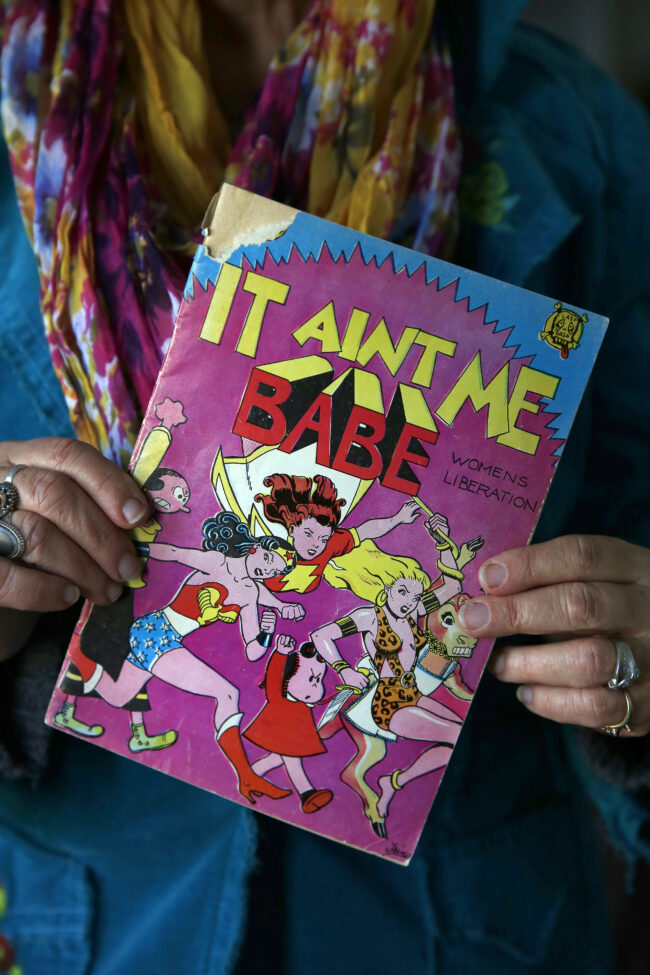Cartoonist and author Trina Robbins—the first woman to draw Wonder Woman—began reading at the age of four. But she began drawing even earlier.
“It was as soon as I could hold a crayon in my chubby hands,” Robbins told The Standard.
Today, at age 84, she’s hard at work on a pro-choice benefit anthology.
Robbins grew up poor and Jewish in Queens, where she longed for a Christmas tree and worshiped her older sister. Her parents showered her with love and never questioned her passion.
“It was never said, ‘Trina wants to be an artist,’ Robbins said of her family. “It was always ‘Trina is an artist.’”
That early support and those early drawings laid the foundation for what would be the structure of her life. Robbins thrived as an underground comics artist in late 1960s San Francisco, before going mainstream with DC Comics in the 1980s. She continues to write and draw to this day, with subjects that range from the Golden Era of Chinatown nightclubs to the history of women cartoonists.
She’s had some incredible adventures along the way.
Robbins left home at 18 and moved to Los Angeles, where she took art classes—and posed nude for men’s magazines after an agent promised he could make her the next Marilyn Monroe. Eventually, she met the man who would become her first and only husband.
“He saved me,” she said of that relationship.
She quit the girlie mags and got into girlie dressing instead. An artist of many stripes, Robbins has creativity infused in her marrow. When her husband, rock critic Paul J. Robbins, gifted her a sewing machine, she began making clothes for herself—and celebrities.
Robbins stitched a dress for Cass Elliot of The Mamas & The Papas and a shirt for David Crosby. And she almost made clothes for Sonny and Cher.
“But I couldn’t do zippers,” Robbins said. “And they wanted zippers.”
Robbins eventually left her husband—”I outgrew him” she said—and moved to New York, where she opened a clothing boutique on the Lower East Side and began drawing in earnest. The boutique, named Broccoli, sold very simple clothes, and became a sort of social center, where artists would gather and discuss ideas.
In 1969, Robbins discovered women’s liberation. “My art got much better and more realistic,” she said. But it was a chance encounter with Robert Crumb’s work at SFO that changed her life forever.
“Someone handed me issue one of Zap,” Robbins said, referring to the famed 1960s underground “comix” series. “And I had this epiphany—you can do these things in a comic book, not just a newspaper.”
Entranced, she closed up her shop and headed west. She received a cold reception in a scene that included only one other woman.
“It was a real boys club,” she said. “It was all anthologies in those days, and they’d never ask me to participate.”
 Artist Trina Robbins | Liz Hafalia/The San Francisco Chronicle via Getty Images
Artist Trina Robbins | Liz Hafalia/The San Francisco Chronicle via Getty Images
It was a different story with the underground newspapers. “My comics were good, and the publishers liked me,” she said. She especially loved drawing for It Ain’t Me Babe, the first feminist newspaper in the U.S., which inspired her to craft an entire feminist comic book.
The 1970 It Ain’t Me Babe was the first all-woman comic book. Asked what it felt like to participate in such a milestone, Robbins demurred.
“I don’t think it hit me at the time,” she said…
Continue reading at Source: The First Woman To Draw Wonder Woman Wants You To Know She’s Alive and Well in SF
Source: The First Woman To Draw Wonder Woman Wants You To Know She’s Alive and Well in SF











Recent Comments